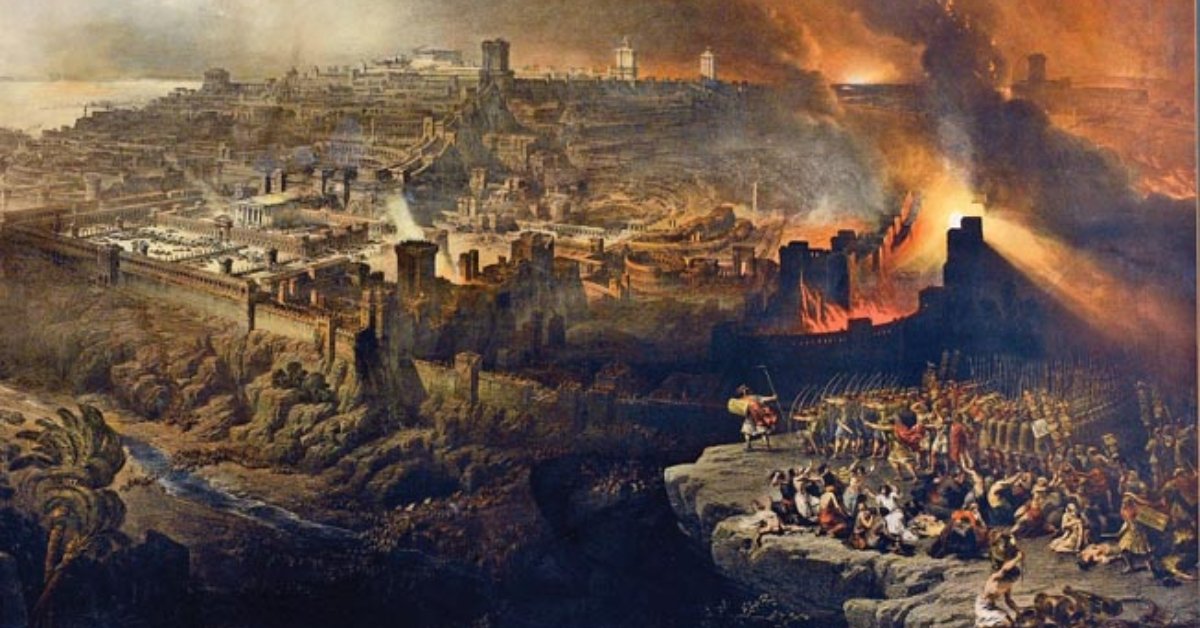Table Of Contents
Hey there, folks!
I am writing this from the team at THOUSIF Inc. – WORLDWIDE, where we love diving into history’s big moments and making them feel alive and relatable.
Today, we are tackling one of those pivotal events that still echoes through time: the Roman destruction of the Second Temple in Jerusalem.
It is a story packed with drama, human struggles, and relevant lessons.
Picture this: ancient empires clashing, a holy site caught in the crossfire, and a people forever changed.
If you are like me, you might have heard bits and pieces in school or from a documentary, but let us unpack it all step by step.
We will explore why it happened, the key players, like Titus and his father, Vespasian, the brutal siege, and what came after.
There is no fancy jargon here, just straightforward storytelling to help you grasp the full picture.
Please grab a cup of coffee and journey back to the first century.
A Quick Look Back: The Second Temple’s Rich History
To understand why the Romans targeted the Temple, we need to start with what it meant to the Jewish people.
The Second Temple was not just a building but the heart of Jewish life, religion, and identity.
Built around 516 BCE after the Babylonians had demolished the original Solomon’s Temple in 587 BCE, this second version symbolized resilience and faith.
Imagine a place where thousands gathered for festivals, offered sacrifices, and felt connected to their God and ancestors.
Thanks to leaders like Zerubbabel, it was rebuilt under Persian rule and later expanded dramatically by King Herod the Great, starting around 20 BCE.
Herod’s makeover turned it into one of the ancient world’s wonders.
He doubled the size of the Temple Mount platform to about 36 acres, bigger than many modern stadiums, and used massive stones, some weighing hundreds of tons.
The Temple complex included courtyards for pilgrims, altars for daily sacrifices, and even a bustling marketplace where people exchanged money and bought animals for offerings.
For Jews everywhere, from Judea to the far reaches of the Roman Empire, Jerusalem was the ultimate pilgrimage spot.
Three major festivals, Passover, Shavuot, and Sukkot, drew crowds from all over and turned Jerusalem into a vibrant hub of celebration and prayer.
However, life under Roman rule was not easy.
Rome had conquered Judea in 63 BCE under Pompey, turning it into a client kingdom and later a province.
The Romans were masters at empire-building, but they often clashed with local customs.
They appointed puppet rulers like Herod, who walked a tightrope between pleasing Rome and keeping his Jewish subjects happy.
After Herod’s death, direct Roman governors took over, and tensions started bubbling.
These officials, called procurators, were often corrupt and insensitive to Jewish religious sensitivities.
For instance, they sometimes misused Temple funds or allowed Roman symbols in holy areas, which felt like a slap in the face to devout Jews.
The Temple was more than religious; it was political and economic, too.
It collected an annual half-shekel tax from Jewish men worldwide, funding its operations and making it a wealthy institution.
Priests ran the show, but factions like the Sadducees (elite priests) and Pharisees (more populist teachers) vied for influence.
Add in radical groups like the Zealots and Sicarii, who hated Roman occupation and dreamed of independence, and you had a powder keg waiting to explode.
Rising Tensions: Seeds Of The Jewish Revolt
So, why did things boil over into a full-blown rebellion?
It was not one single event but a buildup of grievances over decades.
By the mid-60s CE, Judea was a hotbed of discontent.
Roman taxes were crushing, farmers and artisans struggled to pay up, leading to widespread poverty and resentment.
Religious clashes added fuel; for example, Emperor Caligula tried to install his statue in the Temple around 40 CE, which nearly sparked an uprising before his assassination stopped it.
The real spark came in 66 CE under the procurator Gessius Florus.
He seized silver from the Temple treasury to cover unpaid taxes, claiming it was for the emperor.
This outraged the people, leading to riots in Jerusalem.
Florus responded with brutality, crucifying protesters and massacring civilians.
The violence escalated when Jewish rebels attacked Roman garrisons, killing soldiers and seizing control of the city.
They even stopped the daily sacrifices offered on behalf of the Roman emperor, a clear declaration of independence.
This kicked off the First Jewish-Roman War (66-73 CE). At first, the rebels had some successes.
A Roman force led by Cestius Gallus, the governor of Syria, marched on Jerusalem but was ambushed and routed at Beth Horon, losing thousands of troops.
This victory emboldened the Jews, who established a provisional government and fortified the city.
However, internal divisions plagued them from the start.
Moderate leaders wanted negotiation, while radicals like the Zealots pushed for all-out war.
Factions fought each other as much as the Romans, burning food stores and killing rivals in bloody purges.
Meanwhile, Rome was not about to let this slide.
Emperor Nero appointed Vespasian, a seasoned general, to crush the revolt.
Vespasian methodically reconquered Galilee and Judea, avoiding Jerusalem at first to let the infighting weaken the defenders.
By 68 CE, Nero died, and Rome plunged into civil war, the Year of the Four Emperors.
Vespasian emerged as emperor in 69 CE, leaving his son Titus to finish the job in Jerusalem.
Key Players In The Drama
Let us meet the main characters who shaped this tragedy.
On the Roman side, Vespasian was a no-nonsense commander from a humble background who rose through the ranks.
He saw the Jewish revolt as a threat to Roman authority and a chance to boost his career.
His strategy was patient and ruthless: isolate rebels, starve them out, and strike hard.
Titus, Vespasian’s 30-year-old son, took command of the siege.
Historians describe him as brave and charismatic.
He led about 70,000 troops, including four legions hardened by years of campaigning.
Titus wanted a quick victory to prove himself and fund Rome’s treasury with spoils.
He offered surrender terms multiple times, but when rejected, he showed no mercy.
On the Jewish side, leaders were fragmented.
John of Gischala controlled parts of the Temple Mount with his Zealot fighters, fierce nationalists who believed God would deliver victory.
Simon bar Giora led a larger force in the city proper, drawing support from enslaved and low-income people.
Eleazar ben Simon headed another Zealot splinter group.
Their civil war inside the walls doomed the defense; they destroyed vital grain supplies that could have sustained the city for years.
Then there is Josephus, a Jewish commander who defected to the Romans after capture.
He became Titus’s interpreter and later wrote “The Jewish War,” which is our main source for these events.
Josephus tried to persuade his fellow citizens to surrender, arguing that resistance was futile against Rome’s might.
The Brutal Siege Of Jerusalem
By spring 70 CE, Titus’s army encircled Jerusalem, swollen with Passover pilgrims trapped inside.
Estimates vary, but the city might have held over a million people, far beyond its normal capacity.
Titus built a five-mile-long wall around the city, completed in three days, to cut off supplies and prevent escapes.
The siege was hellish.
Romans used battering rams, catapults hurling massive stones, and siege towers to breach the walls.
Jewish defenders fought back with guerrilla tactics, ambushing from tunnels and rooftops.
However, famine hit hard.
People scavenged for food in sewers, ate leather belts, and worse stories of cannibalism emerged, like a mother eating her child out of desperation.
Titus crucified hundreds of captives daily in view of the walls to break morale.
Deserters were disemboweled for swallowing gold.
Despite this, the Jews held out for months.
They repelled initial assaults on the outer walls, but the Romans captured the Antonia Fortress overlooking the Temple by July.
As fighting intensified, flames spread, whether accidentally or on Titus’s orders is debated.
Some say a soldier threw a torch into the Temple’s wooden beams during chaos; others claim Titus wanted it destroyed to crush the Jewish spirit.
The Temple burned on August 30 (or the 9th/10th of Av in the Jewish calendar).
Priests died defending it, and Romans looted treasures like the golden menorah.
The city fell soon after, with massacres and enslavement.
Josephus claimed 1.1 million dead, though modern estimates are lower, around 600,000.
Titus razed most of Jerusalem, leaving only a few towers as reminders of Roman power.
| Timeline |
|---|
| 66 CE: Revolt begins; Romans routed at Beth Horon. |
| 67-69 CE: Vespasian subdues Galilee and Judea; becomes emperor. |
| April 70 CE: Titus arrives with legions; builds circumvallation wall. |
| May-June 70 CE: Outer walls breached; fierce street fighting. |
| July 70 CE: Antonia Fortress falls; assaults on Temple begin. |
| August 70 CE: Temple destroyed on Tisha B’Av; Upper City captured. |
| September 70 CE: Siege ends; survivors enslaved. |
This table gives a snapshot; each phase was marked by incredible bravery and horror.
Digging Deeper: Why Did The Romans Really Destroy The Temple?
Now, the big question: why target the Temple specifically?
It was not just random destruction.
First, the Temple was the revolt’s symbolic center.
Rebels used it as a fortress, storing weapons and holding out there.
Destroying it sent a message: defy Rome, and we will erase your holiest site.
Politically, Vespasian and Titus needed a big win.
The new Flavian dynasty (Vespasian’s family) rose amid Rome’s chaos, and conquering Judea provided propaganda gold.
The Temple’s treasures funded the Colosseum back home, turning Jewish defeat into a Roman spectacle.
Religiously, tensions played a role.
Romans saw the Jewish God as just another deity to conquer, and destroying temples was standard practice in ancient warfare; it broke the enemy’s will.
Some historians argue Titus saw it as divine punishment for rebellion, aligning with Roman views of the gods favoring victors.
Internal Jewish divisions helped, too.
The factions’ infighting weakened defenses, making the Temple vulnerable.
As one ancient writer put it, the destruction happened because of “baseless hatred” among the Jews themselves, a lesson in unity that’s still poignant.
Economically, Rome wanted to eliminate the Temple’s independence.
After the war, they imposed the Fiscus Judaicus, a tax on all Jews empire-wide, redirecting funds to Jupiter’s Temple in Rome.
It was a humiliating reminder of subjugation.
In short, the destruction resulted from military strategy, political ambition, religious clashes, and opportunism.
Titus might not have planned it initially; he reportedly wanted to preserve the Temple as a trophy, but he let it burn once the fire started.
The Aftermath: A World Transformed
The fall of Jerusalem and the Temple sent shockwaves through the ancient world.
For Jews, it was catastrophic.
Temple-based worship ended, there were no more sacrifices, no central holy site, and survivors scattered in the Diaspora, carrying their faith to new lands.
Leaders like Yohanan ben Zakkai escaped and founded academies, shifting Judaism toward prayer, study, and synagogues.
This “Rabbinic Judaism” survives today, with holidays like Tisha B’Av mourning the loss.
Rome celebrated triumphally: Titus paraded captives and spoils through the streets.
The Arch of Titus, still standing, shows the menorah being carried off, a vivid reminder.
The war’s end came in 73 CE with Masada’s fall, when rebels chose suicide over surrender.
Long-term, it reshaped religions.
Christians saw the destruction as fulfilling Jesus’ prophecies, boosting their separation from Judaism.
For Rome, it solidified control but sowed seeds of future revolts, like the Bar Kokhba rebellion in 132-135 CE, which led to even more devastation.
The event inspired art, literature, and longing for restoration in Jewish culture.
Stories of exile spread, with communities tracing roots back to those captives.
It is a tale of loss but also endurance; Judaism adapted and thrived without the Temple.
A Fascinating Trivia Tidbit
Here is something intriguing: The flames were so hot that the Temple’s gold melted and seeped into the stone cracks.
After the fire, Roman soldiers dismantled the walls stone by stone to recover the precious metal.
This fulfilled a biblical prophecy about not one stone left upon another, adding a layer of eerie coincidence to the tragedy.
Wrapping It Up: Lessons From The Ashes
Whew, what a story, right?
From the grandeur of Herod’s Temple to the smoke-filled ruins under Titus, this event reminds us how empires rise and fall, and how faith endures through the worst.
It is a cautionary tale about division, oppression, and the costs of rebellion.
At THOUSIF Inc. – WORLDWIDE, history like this helps us understand our world better, simply, clearly, and humanly.
If this article sparked your interest, check out our other articles on ancient wonders or pivotal wars.
We would love to hear your thoughts in the comments.
What surprises you most about this history? Stay curious, friends!






